Balancing soap pH is essential for skin health, with ideal ranges of 7-10 for soap and 4.5-5.5 for skin. You'll need proper testing tools like pH strips or digital meters to monitor levels throughout production. To correct imbalances, add citric acid for high alkalinity or adjust fat-to-lye ratios for acidic soap. Document each batch's measurements to establish patterns and guarantee consistency. Maintaining this delicate balance protects your skin's natural defenses while providing effective cleansing.
Master Soap Ph: Expert Techniques for Balance
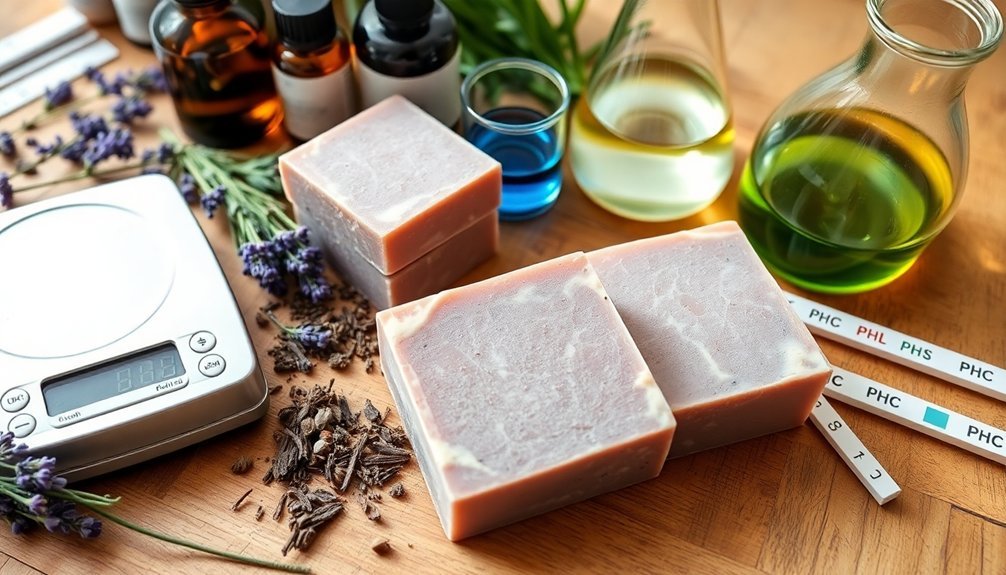
Three critical factors determine your success in soap making: ingredients, technique, and pH balance. Achieving the ideal pH level between 7 and 10 is vital, with most quality artisanal soaps hitting the 8-9 range—slightly alkaline enough to clean effectively without irritating skin.
The saponification process fundamentally affects your soap's final pH, as lye and fats chemically transform. You'll need to regularly test your batches using pH strips or meters to guarantee skin-safe results.
To counteract an overly alkaline product, incorporate naturally acidic pH ingredients like citrus extracts or vinegar. When necessary, make precise adjustments with calculated amounts of citric acid or baking soda based on your specific formulation.
Remember that even small adjustments can appreciably shift your soap's final pH value.
Understanding the Science of Ph in Soap Making
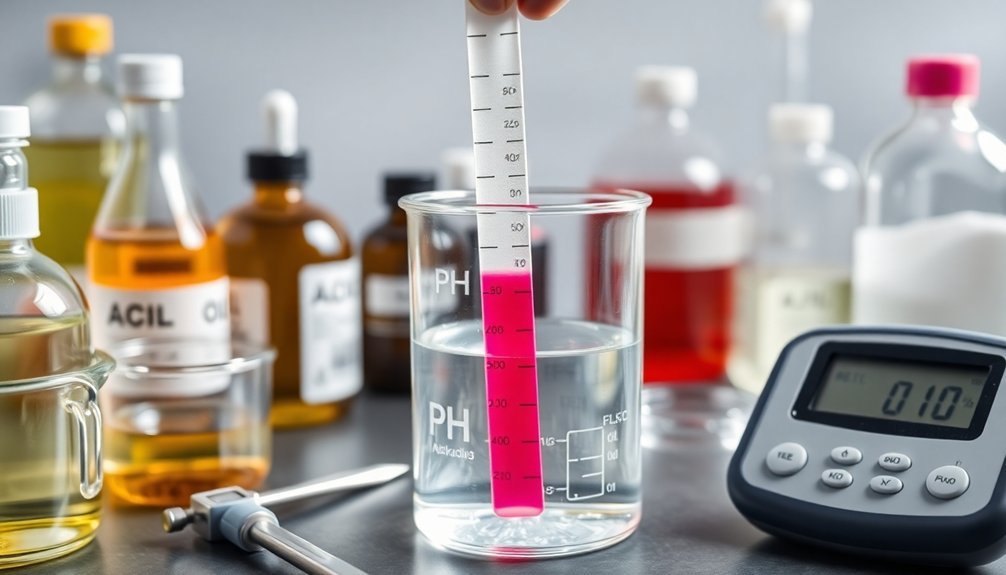
Chemistry lies at the heart of every successful soap batch. When you create soap through saponification, you're transforming oils and lye into a product with pH levels typically between 9-10. This matters because your skin pH naturally hovers around 4.5-5.5, creating an important consideration for formulators.
| pH Range | Effect on Skin | Soap Type |
|---|---|---|
| 4.5-5.5 | Maintains acid mantle | Syndet bars |
| 7.0 | Neutral, gentle | Balanced formulations |
| 9.0-10.0 | Potentially drying | Traditional soap |
You'll need pH strips or meters to test your creations accurately. By adjusting your lye concentration or incorporating acidic additives, you can bring your soap closer to skin-friendly levels. Understanding how each ingredient affects the final pH helps you craft products that clean effectively while respecting your skin's natural balance.
The Acid Mantle: Why Ph Matters for Skin Health
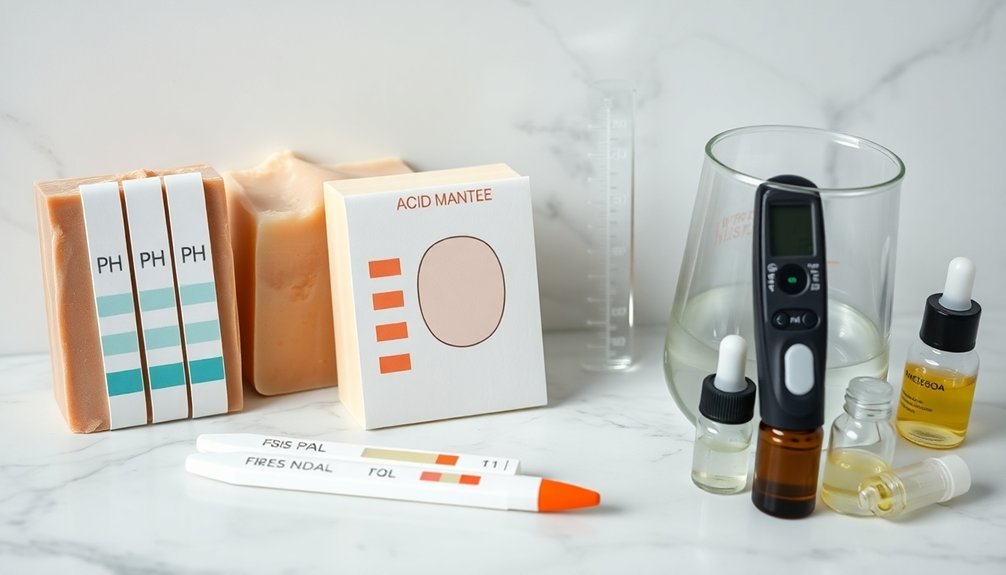
Your skin's acid mantle forms a critical protective barrier with a pH of 4.5-6.5, shielding you from harmful pathogens while retaining essential moisture.
This slightly acidic environment supports your skin's microbiome equilibrium by encouraging beneficial bacteria growth while inhibiting harmful microorganisms.
When you use soaps with appropriate pH levels, you're helping maintain this delicate balance, preventing irritation and supporting your skin's natural defense mechanisms.
Protective Barrier Function
Skin's first line of defense lies in an often-overlooked microscopic shield: the acid mantle. This slightly acidic film (pH 4.5-6.5) creates an inhospitable environment for harmful pathogens while supporting beneficial microbes that contribute to your skin's resilience.
When you use highly alkaline soaps, you're temporarily stripping this protective barrier, leaving your skin vulnerable.
Your acid mantle doesn't just fight infection—it's integral to overall skin health:
- Maintains moisture balance by preventing excessive transepidermal water loss
- Supports enzymatic activity essential for proper skin cell turnover
- Neutralizes environmental threats including pollution and UV damage
Though your skin can naturally rebalance its pH, repeated disruption overwhelms this recovery mechanism.
Choosing pH-balanced cleansers helps preserve this delicate protective layer, ensuring your skin remains healthy and resilient.
Microbiome Equilibrium Maintenance
The delicate ecosystem residing on your skin—comprised of trillions of microorganisms—functions efficiently when your acid mantle maintains its ideal pH of 4.5-6.5. This slightly acidic environment, ideally around pH 5.5, nurtures beneficial bacteria while inhibiting pathogenic microbes that threaten your skin barrier.
When you use products that aren't pH balanced, you risk disrupting this microbiome harmony. Though your skin can rebalance itself after occasional pH fluctuations, consistent use of alkaline products gradually weakens your natural defenses, potentially leading to sensitivity, irritation, and infections.
To maintain microbiome equilibrium, select soap and skincare formulations that respect your skin's natural acidity. This thoughtful approach supports your acid mantle's protective functions, ensuring your skin microbiome remains diverse and healthy—your first line of defense against environmental challenges.
Essential Tools for Accurate Ph Testing
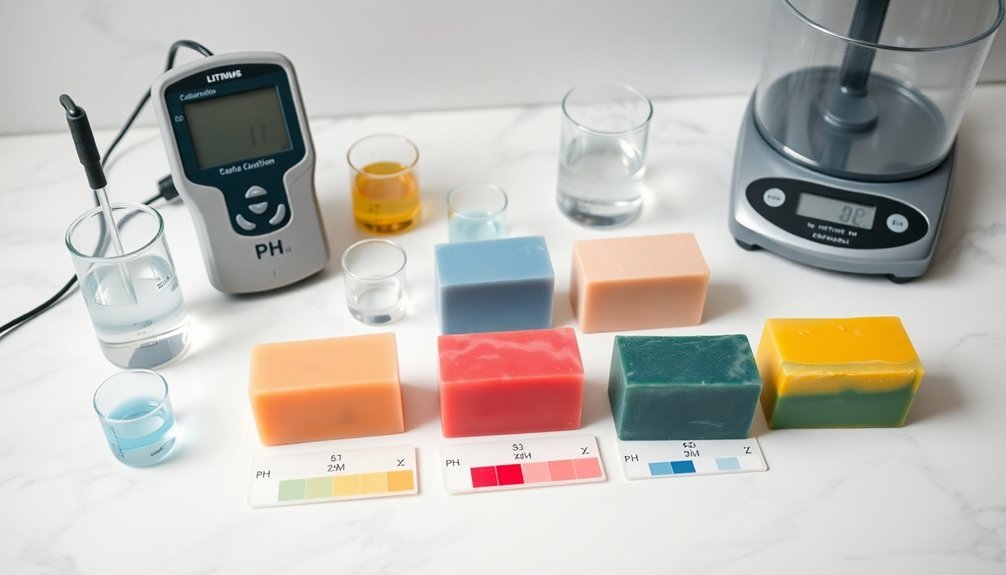
Precision in pH measurement forms the foundation of successful soap making. To achieve accuracy in pH testing, you'll need either a digital pH meter or pH test strips.
pH meters offer digital readouts with greater precision and can be calibrated for professional-level results, while test strips provide a more affordable option for hobbyists, though with slightly less precise readings.
- Always clean your testing tools before use to prevent contamination that could skew results
- Calibrate pH meters according to manufacturer instructions for peak accuracy
- Maintain a testing log to track pH levels throughout your soap-making process
Remember that consistent monitoring helps guarantee your final product meets specifications.
Natural Ingredients That Influence Soap Ph
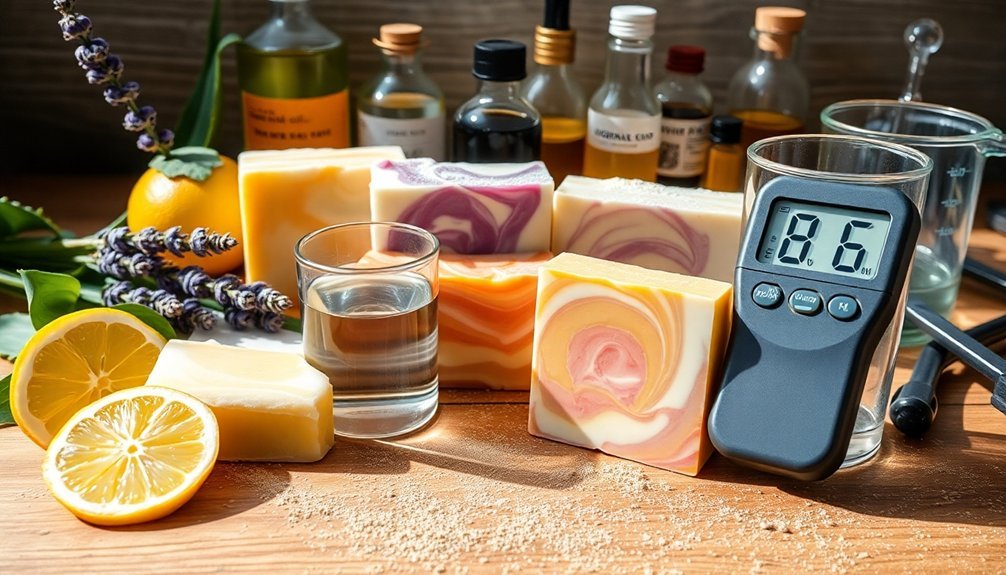
Citrus essential oils can greatly lower your soap's pH due to their naturally acidic properties, making them valuable tools when you're aiming for a gentler, less alkaline product.
You'll find botanical ingredients like aloe vera and seaweed serve as excellent pH balancing agents, helping to maintain an ideal pH while adding skin-soothing benefits.
When incorporated thoughtfully into your formulations, these natural ingredients allow you to manipulate your soap's pH without resorting to synthetic additives or harsh chemicals.
Citrus Oils Impact
Among the many natural ingredients that can markedly alter your soap's pH level, citrus oils stand out for their distinctive acidic properties. With natural pH levels between 2 and 3, lemon and orange oils help lower pH in your alkaline soap mixtures, creating more skin-friendly products.
These versatile oils don't just contribute invigorating scents—they also enhance the saponification process, making your soap more effective.
- Add citrus oils strategically to balance your soap's pH without over-acidifying the formula
- Leverage their natural antibacterial properties from citric acid content for added cleansing benefits
- Start with small amounts (0.5-1% of total recipe) and adjust based on pH testing results
Remember to use citrus oils in moderation, as excessive amounts may irritate sensitive skin or destabilize your soap's chemical structure.
Botanical Balancing Agents
Five key botanical ingredients serve as natural pH regulators in your soap formulations. Aloe vera and chamomile provide mild acidity and soothing properties that naturally adjust soap pH while promoting skin health.
When you're seeking to lower pH levels, consider citric acid from citrus fruits, which enhances skin compatibility while adding pleasant scents to your creations.
Don't overlook the power of base oils—coconut and olive oils contain fatty acids that contribute slightly acidic properties, improving moisture retention.
Green tea and calendula extracts offer dual benefits: antioxidant protection and natural acidity that maintains balanced pH.
For enhanced effectiveness, incorporate honey and yogurt as botanical balancing agents that improve your soap's feel against the skin while maintaining ideal pH levels for healthy skin barrier function.
Cold Process vs. Hot Process: Ph Differences
When you're comparing soap-making methods, pH levels represent one of the most significant differences between cold process and hot process techniques.
Cold process soap typically starts with a higher pH (9-11) after saponification, gradually decreasing during the weeks-long curing period. In contrast, hot process soap reaches a lower, more stable pH (8-9) immediately after cooking, as heat accelerates the saponification reaction.
- Your pH following will vary depending on method—cold process requires patience while the soap neutralizes over 4-6 weeks.
- Cold process soap offers greater creative possibilities but demands more precise pH monitoring.
- Hot process soaps can be used sooner after production, making them ideal when you need faster turnaround.
Understanding these pH differences helps you select the appropriate method for your specific soap-making goals and customer needs.
Troubleshooting Common Ph Imbalances
When you're faced with highly alkaline soap, you'll need to carefully introduce acidic elements like citric acid or vinegar during the mixing stage while monitoring with an accurate testing kit.
If your soap has become too acidic, revisit your oil selections and consider adjusting the fat-to-lye ratio in your next batch to achieve proper saponification.
Remember that accurate measurement tools and quality ingredients, particularly distilled water instead of mineral-rich tap water, are your best defenses against pH imbalances that could irritate your skin.
High Alkalinity Correction Methods
Despite your best efforts, high alkalinity remains one of the most common issues soap makers encounter. When your soap tests highly alkaline, you can incorporate acidic ingredients like citric acid or vinegar during formulation to lower the pH. Aim for the skin-friendly range of 4.5 to 5.5, testing with pH strips after each adjustment.
Consider these effective correction techniques:
- Rebatch your soap with distilled water and a small amount of citric acid to encourage further saponification.
- Add superfatting agents such as extra oils to counterbalance alkalinity while improving moisturizing properties.
- Monitor pH levels consistently throughout the soap-making process, especially after saponification completes.
Regular testing is essential—catching pH imbalances early saves you time and prevents skin irritation in your final product.
Acidic Soap Solutions
Balance represents the cornerstone of effective soap formulation, particularly when addressing acidic solutions.
When working with acidic soaps, aim for a pH between 4.5 and 5.5 to maintain your skin's natural protective barrier against bacteria and moisture loss.
If you encounter pH imbalances, examine your formulation for harsh alkaline ingredients that may disrupt your skin's natural pH.
Consider substituting milder acids like citric or lactic acid, which effectively balance pH without compromising your soap's performance.
Always test your finished product using pH strips or a meter to confirm it falls within the ideal range.
For peak skin health, follow your cleansing routine with a pH-balanced toner to restore and maintain your skin's natural pH levels, enhancing its protective capabilities and overall health.
Testing Kit Accuracy
How accurately does your pH testing kit measure? Reliable pH measurements are essential for creating skin-safe soaps, but many factors can compromise testing kit accuracy.
Temperature fluctuations, impure water samples, and aging test materials can all skew your results, leading to formulation errors.
To guarantee dependable readings:
- Store test strips in cool, dry places away from direct sunlight to prevent degradation that affects accuracy
- Calibrate pH meters regularly using fresh buffer solutions at room temperature
- Cross-reference results using multiple testing methods when troubleshooting problematic batches
Remember that understanding your soap's ideal pH range (typically 8-10 for bar soaps) compared to skin's natural pH (around 5.5) provides context for your measurements.
When results seem suspicious, check your testing tools first before adjusting your formula.
Strategic Use of Citric Acid and Vinegar
While creating the perfect soap formulation, you'll often need to adjust pH levels to achieve skin-friendly products.
Citric acid derived from citrus fruits offers precise control when lowering pH. Add it gradually while testing frequently, as even small amounts can considerably shift your soap's acidity.
Alternatively, vinegar provides an eco-friendly option for pH adjustment. Use 10% concentrations for minor tweaks or 30% strength when more substantial changes are required.
Beyond pH correction, vinegar adds mild antibacterial properties to enhance your soap's cleansing power.
Whichever option you choose, always retest after making adjustments to verify your final product falls within the ideal 4.5-5.5 pH range.
This careful balancing creates gentle formulations that won't disrupt your skin's natural barrier.
Neutralizing Techniques for Alkaline Soaps
Most commercial soaps tend toward high alkalinity, which can strip your skin's natural oils and cause irritation.
To create gentler products, you'll need effective neutralizing techniques that bring pH levels into the skin-friendly range of 4.5 to 5.5.
Acidic additives are your best allies in this process. Add small amounts of vinegar or citric acid to your soap mixture, carefully monitoring with pH strips as you go.
You can also incorporate naturally acidic ingredients like yogurt or honey, which balance pH while enhancing moisture retention.
- Adjust superfatting levels in cold process soaps for less alkaline results
- Test pH regularly during production to maintain ideal levels
- Start with small amounts of acidic additives (0.5-1%) and increase gradually if needed
Curing Time: Its Effect on Final Ph Levels
Beyond adding neutralizing agents, the natural curing process considerably impacts your soap's final pH. Freshly made cold process soap typically starts with a harsh pH between 10-12, potentially irritating skin if used prematurely.
During the 4-6 week curing time, critical chemical changes occur as saponification completes. This period allows excess moisture to evaporate while pH levels gradually decrease to a gentler 7-9 range.
You'll notice your soap becoming harder and milder with each passing week. Environmental conditions matter too—higher humidity and cooler temperatures can extend necessary curing time and affect final pH levels.
Always test your soap's pH before use; readings above 9 suggest incomplete saponification that may harm skin. Patient curing rewards you with balanced, skin-friendly soap.
Specialty Formulations for Sensitive Skin
Creating effective soaps for sensitive skin requires a fundamental shift in formulation philosophy. When developing these products, you'll need to maintain pH levels close to 5.5, mimicking skin's natural acid mantle to preserve barrier function.
Select gentle surfactants derived from coconut rather than harsh detergents that strip away natural oils and butters essential to maintain skin health.
- Incorporate soothing botanical ingredients like oat extract, chamomile, or calendula to reduce irritation and calm reactive skin.
- Add emollients such as shea butter or jojoba oil to hydrate and protect while balancing moisture levels.
- Choose hypoallergenic fragrances or select essential oils known for their non-irritating properties to enhance the sensory experience without triggering sensitivity.
Documenting and Tracking Ph Across Batches
Consistent quality control in soap making hinges on meticulous pH documentation across your production batches.
Implement a standardized logging system that captures pH readings at multiple stages—before saponification, after mixing, and post-curing—using reliable testing methods like pH strips or digital meters.
Record specific ingredient proportions alongside pH measurements, as variations in oils, lye concentration, and additives directly impact your final product's acidity.
This thorough tracking enables you to identify successful formulations that deliver skin-compatible soaps consistently.
Regularly analyze your historical pH data to recognize patterns between production variables and results.
This systematic approach reveals how process modifications affect your soap's pH balance over time, allowing you to refine techniques and troubleshoot issues quickly when they arise.
Your documentation serves as your roadmap to predictable, skin-safe formulations.
Frequently Asked Questions
How Can I Balance My Body Ph Quickly?
You'll balance your body pH quickly by eating alkaline foods like leafy greens and bananas, drinking water with lemon, consuming potassium-rich foods, exercising regularly, and reducing processed foods and sugar intake.
What Are Signs My Ph Balance Is Off?
Signs your pH balance is off include redness, irritation, dryness, and increased sensitivity on your skin. You'll also notice breakouts, excessive oiliness, or flakiness. Your skin might feel tight, uncomfortable, or abnormally reactive to products.
How Do You Fix Unbalanced Skin Ph?
Use gentle pH-balanced cleansers (4.5-5.5), hydrating toners with witch hazel or rose water, and moisturizers with EFAs. Choose mildly acidic products and watch your lifestyle factors—stress and environment can affect your skin's pH balance.
Does Ph Balance Body Wash Work?
pH-balanced body wash can work, but it's not a miracle solution. Your skin self-regulates within minutes anyway. Focus on how your skin feels after using a product rather than just its pH level.
In Summary
You've now mastered the essential techniques for balancing soap pH. By understanding the science, respecting the acid mantle, and using proper testing methods, you're creating products that truly nurture skin. Remember, consistent documentation and patience during curing will refine your craft. Whether you're formulating for sensitive skin or experimenting with natural ingredients, you'll achieve the perfect pH balance with each batch you create.
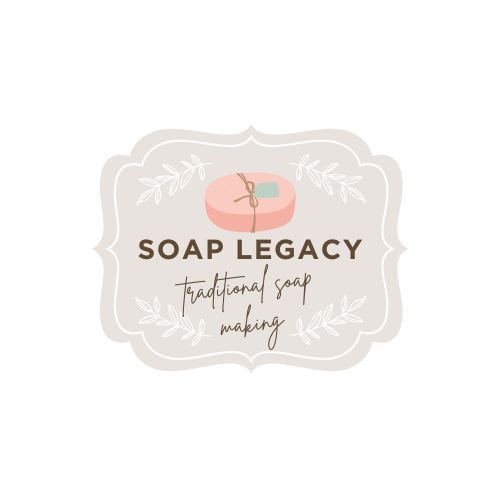

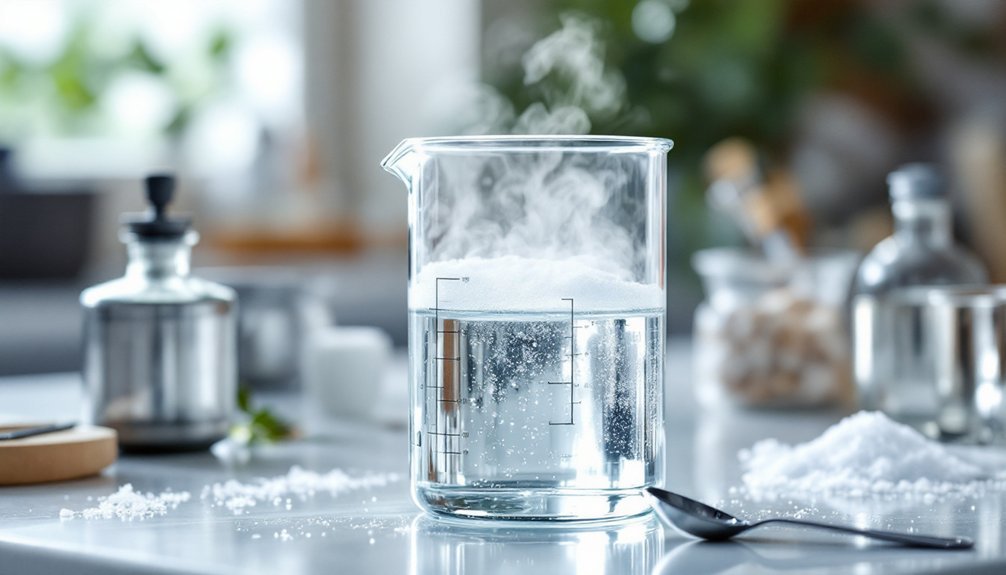
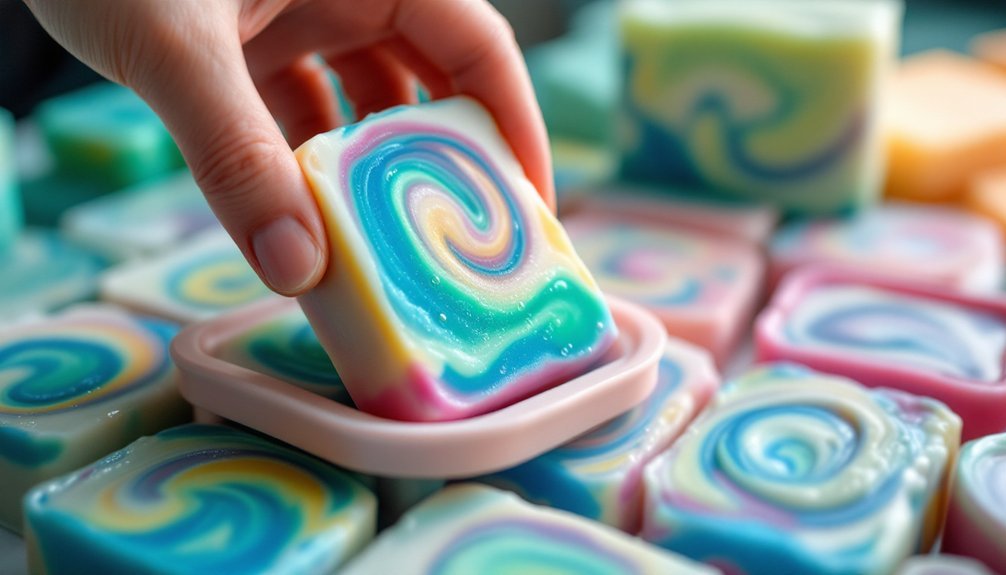

Leave a Reply